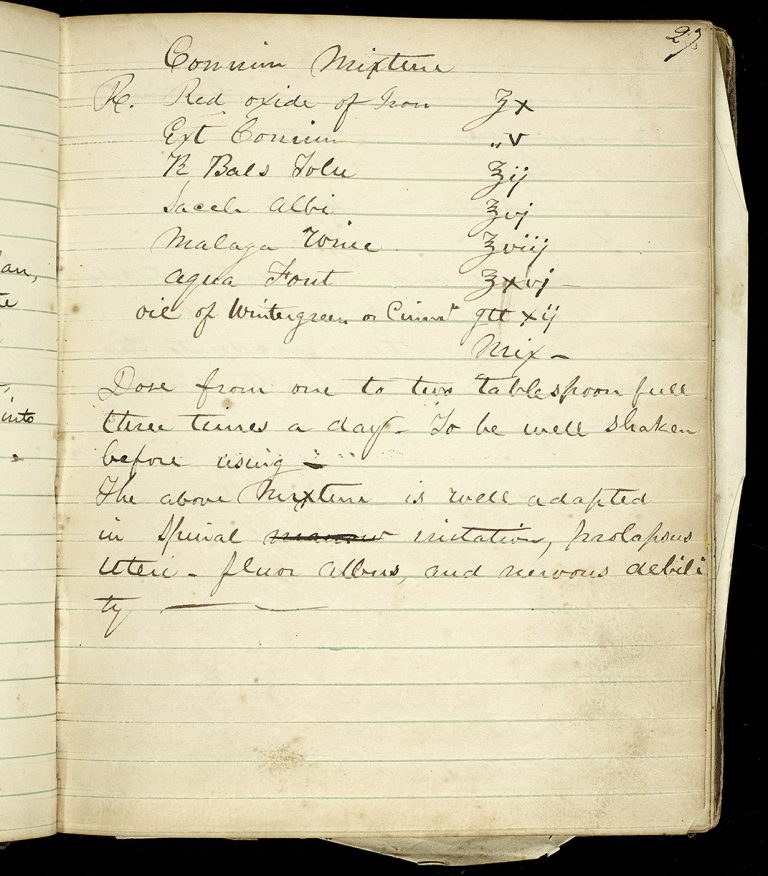Subject: 26-D-4's Box 92 Discoveries
-guest post from summer intern Whimsy Mark-Ockerbloom

Two wooden boxes thought to contain medical instruments.
Identifying objects in the Archives can be a struggle. I see it as solving a mystery, piecing together a puzzle, and falling down a rabbit hole of medical devices, professionals, and treatments. In the time I’ve worked on this project, I’ve opened old tomes, unclasped bags of suspicious pills, unexpectedly come upon lots of sharp objects, been excited, disappointed, and most often, been really glad I wear gloves. There’s nothing like the excitement of opening a box identified as a ‘bone saw’, then the letdown of holding a rib spreader, then the uncomfortable realization that at some point this was holding someone’s chest cavity open. Again, I’m often reminded what a good thing it is that I wear gloves.
When I first opened the box labeled “Hottenstein M.D.”, my target was an object listed only as “Unidentified Medical Instrument”. I idly noted the listing for “2 wooden boxes with medical instruments” that was equally as vague. One part of identifying a specific object is figuring out which object you’re supposed to be identifying, and sorting the nasal speculums from the obstetric forceps from the ‘unidentified medical instrument with screw on one end’. So I sort out the items that are already identified by noting the contents of boxes and consulting Google for the more complicated medical words. I separate the vague wooden boxes from the rest, one of which contains a small operating kit and the other, more of a drawer, containing parts of a balance scale. The strange hole on the top of the drawer catches my interest.
With all the other objects sorted out, I find the “Unidentified Medical Instrument”. From a cursory glance, I have no idea what this thing is. It’s a cylindrical metal object, with a strangely shaped tip. A lever at the bottom raises and lowers the stick supporting said tip, and I cannot for the life of me figure out what medical purpose this thing could serve. Unable to think of any keywords for a google search, (weird cylinder medical thing doesn’t provide any useful results for some reason), I flip through my book of surgical instruments in the hopes of stumbling upon something of similar appearance. Nothing matches up. Is this thing even a medical instrument?
Frustrated, I turn my attention to the wooden boxes, adding their clarifying information to their original inventory. It’s then that the strange hole pulls my attention again. On a whim, I pick up the ‘unidentified medical instrument’ and position it in the hole. It’s a perfect fit. The non-circular shape of the hole allows for the lever to be adjusted, in turn adjusting the height of the instrument. Finally putting two and two together, I empty the drawer again, and begin constructing what is now, clearly, a balance scale.
But what does a balance scale have to do with medicine? In an extremely professional fashion, I started playing with the weights in the drawer, measuring them against each other. Searching for more things to weigh, I opened the small box of “Aluminum Weights” and found what looked like small, foreign coins in varying sizes, labeled “drachms”. Chasing down this new, draconian-sounding lead brought me into the history and practices of the apothecaries.
The ‘Drachma’ originated in Greece as both a currency and a unit of measurement. The value of money was represented by the value of the coin itself, so the weight of the silver that made up the coin corresponded to how much the coin was worth. Over time, the drachma persisted as a unit of measurement in apothecaries, although its name changed, sometimes the classic ‘drachma’, sometimes simply ‘dram’, and in British apothecaries, the “drachm”. The drachm remained a part of british apothecary measurements until 1858, when the British Pharmacopoeia ordered usage of the weight discontinued. Drachms, as a standardized form of measurement, appeared commonly in physician’s recipes. Similarly to how today, one may see recommendations of a teaspoon of salt or a cup of flour, a physician may have read a recommendation of opium, one drachm by weight. I certainly hope no one mixed their recipes and ended up putting opium in their poundcakes.

Jacob G. Shoch medicinal and household recipe notebook, using the symbol ʒ (or ℨ) for fluid drachm.

Medicinal and household recipe notebook from Theodore Geiger papers, with recipe illustrating the use of the symbol ʒ (or ℨ) for fluid drachm. Likely dated around 1880.
It’s not every day that I get to find two supposedly unrelated objects and fit them together, completing a puzzle that I didn’t know existed. It’s not every day I get to go down a medical rabbit hole, learning about ancient forms of measurement and reading recipes for concoctions no physician today would attempt to touch. But sometimes, the archives reveal one of their mysteries.
Sources:
General Medical Council (Great Britain), British pharmacopoeia, 1864."
David Hottenstein collection, Drexel College of Medicine Legacy Center.